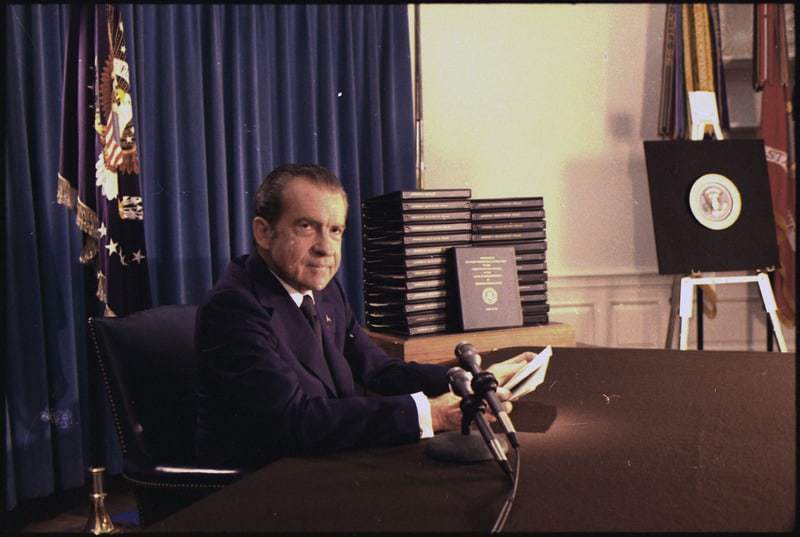There was a reason he was called “Tricky Dick”. Since the multitude of crimes he committed in his political career have faded with time, some have tried to resurrect the reputation of Richard Nixon. They cite his visit to China, his resolution of the Vietnam War as “peace with honor” (it was neither) and other accomplishments as indications that his Presidency was in many ways successful. To these revisionists, the crimes and scandals which marked his career were nothing more than what any politician does, and Nixon was scapegoated for the crimes of many.
Richard Nixon’s crimes went far beyond Watergate. His abuse of power, his use of the IRS, FBI and CIA against his perceived enemies, his obstruction of justice, payment of hush money, maintenance of an enemies list, are just a few of the crimes he committed while President and while trying to become President. Most of his criminal activities are forgotten, other than the Watergate scandal, itself not one crime, but a long series of criminal behavior by the President and his underlings. Some wish to forgive him simply because he was a Republican, the victim of the liberal media and a Democratic Congress. Nixon’s contempt for the document that he was sworn to, “…preserve, protect, and defend…” is worthy of study especially today.

Here are ten crimes committed by Richard Nixon and his administration.

Lyndon Johnson accused Candidate Nixon of Treason
In December of 2008 tapes of telephone conversations recorded in the Oval Office during the administration of Lyndon Johnson in 1968 were released to the public. In one of these tapes, Johnson reports to Senator Everett Dirksen, then the leader of the Republican’s in the Senate, that Nixon, the GOP nominee for President in the thick of a campaign, was committing treason. Dirksen did not argue or defend the Republican nominee. The Nixon campaign was deliberately acting to impede the progress of the Paris Peace Talks, which were then attempting to find a peaceful solution to the Vietnam War.
That October 1968, Johnson ordered a stop to the bombing which had pounded North Vietnam since 1965, Operation Rolling Thunder, in response to the North Vietnamese agreeing to engage in Peace Talks. Nixon, who had seen a large lead in the polls over his Democratic opponent shrink alarmingly, publicly announced that he supported the idea of peace talks. Privately he opened a channel to the Vietnamese government with the intention of sabotaging the peace talks and postponing any breakthroughs towards a settlement until after the election.
Nixon established a firm working relationship with Henry Kissinger, who also had contacts within the White House and the campaign of Nixon’s main opponent, Hubert Humphrey. Through Kissinger, the Nixon campaign kept apprised of the status of the peace talks and the Johnson administration’s efforts to move them forward. A prime sticking point of the talks was the insistence on the part of the North Vietnamese that the National Liberation Front (Viet Cong) be included in the negotiations. The South Vietnamese government under President Thieu did not recognize the existence of the NLF and refused to enter into negotiations with them, effectively blocking any progress.
The Nixon campaign maintained a dialogue with Anna Chennault, an Asian-American with influence with President Thieu. She was also the widow of General Claire Chennault, who had commanded the famous Flying Tigers American Volunteer Group during the Second World War. Through Chennault, the Nixon campaign persuaded Thieu that the Johnson administration and by extension that of his successor, Hubert Humphrey (if he won) would abandon the South Vietnamese government in order to achieve a peace agreement. The Nixon campaign promised to uphold South Vietnam after winning office in November.
Once the Nixon administration achieved office in January of 1969, Kissinger and his North Vietnamese contemporary Le Duc Tho entered into secret negotiations outside of the peace talks, which continued but which were largely inconsequential. Eventually, they agreed to a cease-fire in place, meaning the Viet Cong would remain where they were at the time of the agreement. Between January 1969 and the signing of the ceasefire agreement, another 20,863 Americans were killed in Vietnam. Whether their lives would have been saved had South Vietnam entered into serious negotiations in 1968 is speculation, that Richard Nixon impeded serious talks that year in order to improve his chances to win the Presidency is not.

